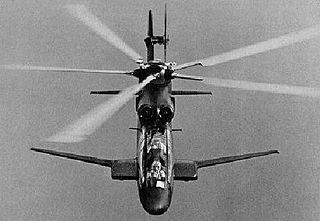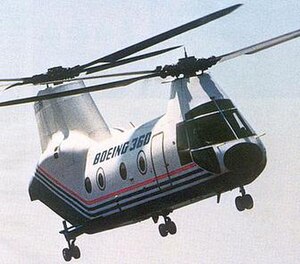
The Boeing Vertol CH-46 Sea Knight is a medium-lift tandem-rotor transport helicopter powered by twin turboshaft engines. It was designed by Vertol and manufactured by Boeing Vertol following Vertol's acquisition by Boeing.

The Bell XV-15 is an American tiltrotor VTOL aircraft. It was the second successful experimental tiltrotor aircraft and the first to demonstrate the concept's high speed performance relative to conventional helicopters.

The Mil Mi-34 is a light helicopter designed by the Mil Moscow Helicopter Plant in either a two or four seat configuration for utility and training. It was first flown on 17 November 1986 and introduced at the Paris Air Show in 1987. The Mi-34 entered production in 1993, and is capable of performing aerobatic manoeuvres, including rolls and loops.

The Sikorsky S-67 Blackhawk was a private-venture, prototype attack helicopter built in 1970 with Sikorsky Aircraft research and development (R&D) funds. A tandem, two-seat aircraft designed around the dynamic drive and rotor systems of the Sikorsky S-61, it was designed to serve as an attack helicopter or to transport up to eight troops into combat.

The PZL Kania is a follow-up design to the Mil Mi-2 helicopter, developed in Poland by PZL-Świdnik.

The Hughes TH-55 Osage is a piston-powered light training helicopter produced for the United States Army. It was also produced as the Model 269 family of light utility helicopters, some of which were marketed as the Model 300. The Model 300C was produced and further developed by Schweizer after 1983.

The Sikorsky CH-53K King Stallion is a heavy-lift cargo helicopter designed and produced by Sikorsky Aircraft. The King Stallion is an evolution of the long running CH-53 series of helicopters which have been in continuous service since 1966, and features three uprated 7,500 shp (5,590 kW) engines, new composite rotor blades, and a wider aircraft cabin than its predecessors. It is the largest and heaviest helicopter in the U.S. military.

The Boeing Vertol YUH-61 was a twin turbine-engined, medium-lift, military assault/utility helicopter. The YUH-61 was the runner-up in the United States Army Utility Tactical Transport Aircraft System (UTTAS) competition in the early 1970s to replace the Bell UH-1 Iroquois helicopter. At the end of the flyoff program, Sikorsky Aircraft was awarded a contract to develop and build its UH-60A entry.

The Brantly B-2 is an American two-seat light helicopter produced by the Brantly Helicopter Corporation.

The Sikorsky S-75 was a proof-of-concept all-composite helicopter. Sikorsky Aircraft used all-composite materials to replace metal to provide greater strength, lighter weight, lower manufacturing costs, and reduce maintenance costs.

The Brantly 305 is an American five-seat light helicopter of the 1960s. It is an enlarged version of the Brantly B-2 which was produced by the Brantly Helicopter Corporation.
The Fiat Model 7002 was a 1960s Italian general-purpose helicopter with a tip jet driven rotor built by Fiat Aviazione. Only one aircraft was built.

The Firestone XR-9, also known by the company designation Model 45, was a 1940s American experimental helicopter built by the Firestone Aircraft Company for the United States Army Air Forces. Only two were built.
The Kamov Ka-126 is a Soviet light utility helicopter with co-axial rotors. Evolved from Ka-26 with engine pods removed from stub wings, fitted with one TVO-100 turboshaft engine positioned on top of fuselage, modified rotor blades, new fuel system.
The American Aircraft Penetrator, now referred as the Aerocraft Stealth Star 204 SS, was a gunship helicopter modified from the Bell UH-1B Iroquois with tandem seating for the pilots and a troop-carrying compartment.

The Cicaré CH-7 and Heli-Sport CH7 are a series of ultralight, kit-built helicopters based on a single-seat Argentinian design from the late 1980s. It was later developed into a tandem two-seater, and remains in production.
The Midwest Zodiac Talon-Turbine is an American helicopter that was designed and produced by Midwest Engineering & Design of Overland Park, Kansas. When it was available the aircraft was supplied in the form of plans for amateur construction, but the plans are no longer advertised for sale.
The IRI T22B is an Italian helicopter that was designed and produced by Italian Rotors Industries of Aprilia, Lazio. Now out of production, when it was available the aircraft was supplied complete and ready-to-fly.
The IRI T250A is an Italian helicopter that was designed and produced by Italian Rotors Industries of Aprilia, Lazio and introduced in 2015. Now out of production, when it was available the aircraft was supplied complete and ready-to-fly.
The SKT Skyrider 06 is a Swiss helicopter, designed and produced by SKT Swiss Kopter Technology SA of Ambrì. It was first flown in 2013 and entered series production in January 2014. The aircraft is supplied complete and ready-to-fly.













